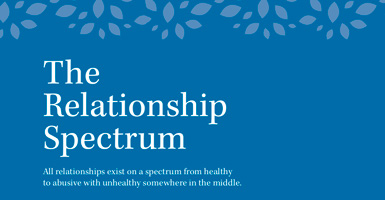School is back in session, which means there’s plenty of opportunity for teens to develop new relationships. For middle school and high school students, this can be an overwhelming time, filled with roller coaster emotions and peer pressure. It’s important for everyone, especially parents, to know and understand signs and expectations of a healthy relationship, as well as an abusive one.
It’s up to you to start the conversation. A helpful tool that our training team uses to educate the community is called the relationship spectrum PDF (loveisrespect.org). Here’s a quick snapshot:
In healthy relationships, you make decisions together and can openly discuss relationship problems. You enjoy time together but can also be happy apart.
In unhealthy relationships, one person tries to make most of the decisions. He or she may try to pressure the partner about sex or refuse to admit hurtful actions. In an unhealthy relationship, you feel like you need to spend time with only your partner.
In abusive relationships, one person is making all decisions – this includes friend groups, sexual choices and boundaries. The abuser’s goal is to have all the power and control. The victim may feel like he or she can’t talk to other people, especially about what’s really happening in the relationship.
Today, a more common form of abuse is digital dating abuse, which is perpetuated through the use of technology, including excessive texting, harassment via social media and pressure to send and receive unwanted sexual photos and messages.

Warning Signs
Look for early warning signs of relationship abuse, such as:
- Problems with school attendance
- Lack of interest in former extracurricular activities
- Isolation from former friends
- Unexplained bruising or injuries
- Making excuses or apologizing for partner’s behavior
- Noticeable change in weight, demeanor or physical appearance
How Can Parents Help?
Trust your instincts. Parents can help by telling their teens that everyone deserves a safe and healthy relationship. Start talking early and get to know your teens’ friends in various social groups. Keep in mind that your teen could mistake expressions of “love” when in fact they are warning signs of abuse. Remember to emphasize that your teen isn’t to blame for what’s happening.
If your teen doesn’t want to talk, it doesn’t mean they aren’t listening. Try coming back to the conversation another day. Or, ask if they’re more comfortable speaking with a friend, coach or other trusted adult. It’s important that both boys and girls know what’s acceptable in their relationships. Learn more from our downloadable brochure.
Help Break the Cycle
If you think you’ve seen abuse or have questions, risk being right. Call, text or chat with our Where’s The Line? Information Coordinator. The Where’s The Line? campaign is a central Ohio resource for bystanders to utilize in order to safely help victims and to recognize warning signs of violence and abuse. Contact us at WheresTheLine.info.
If you are a bystander and witness physical harm, please call 911 immediately.

Additional Online Resources
If your teen has a smart phone, encourage him or her to download these safety apps:
Mobile Apps
- BSafeYou
www.getbsafe.com - Circle of 6
www.circleof6app.com - One Love – My Plan
www.joinonelove.org/my_plan_app
Training
We offer free community training on digital dating abuse, teen dating abuse and more. To request a free training session, visit the Programs & Services tab on our website, www.familysafetyandhealing.org.
Relationship Spectrum Activity
The Relationship Spectrum helps individuals or groups to learn about healthy, unhealthy, and abusive relationships. Download it here or by clicking the image below.


Leave a Response